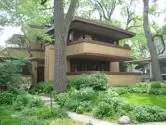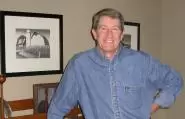The Streets of Oak Park – An Architectural Evolution

Oak Park, you may recall from last week, began as an affluent suburb about ten miles west of downtown Chicago. It was there that 22-year-old Frank Lloyd Wright bought a corner lot where he designed and built a shingle-style home for his first wife, Catherine, and what would become their brood of six children. A few years later Wright built an adjacent studio for his burgeoning architectural business and, as they say, the rest is history.
Today the Frank Lloyd Wright Home and Studio, restored to how the two buildings appeared in 1909, is a major attraction for Oak Park and River Forest next door. But those who take the thirty-minute tour and leave Oak Park thinking they then know Frank Lloyd Wright are missing something.
Certainly, the casual visitor will later recall how Wright kept the ceilings low and the backs of the dining room chairs high to create a sense of intimacy. And how he never stopped experimenting with his own house, adding alcoves, putting stained glass in the ceiling, building a roof around a tree rather than cutting it down, designing a playroom for his children that feels like a small theatre.
But the village of Oak Park was his real-life laboratory, where his imagination and his creativity were turned loose, financed by clients who seemingly were either mesmerized by the young, brash architect or who shared his flair for the unconventional approach to residential design. Between 1889 and his forced exodus in 1909, Wright designed and saw built no fewer than 35 homes in Oak Park and River Forest, the majority literally just blocks from one another.
After the tour, you slip out of the low ceilings of his home and onto the broad Chicago Avenue and there you immediately discover three homes Wright designed around 1892, early in his career, when Victorian turrets and peaked roofs were still in his vocabulary.
And there for the first time, perhaps, you realize that this idea he had for what we would label the Prairie School style did not just pop into his mind one day as a fully conceived idea. Instead, you note, as you turn onto North Forest Street and find yourself standing in front of the Arthur Heurtley House, that by 1902 the roof had begun to flatten, that the windows had begun to rise up the walls and that the entrance was now hidden in a maze of low brick walls.
A few blocks away, on East Street, you stand in front of the ill-fated Edwin Cheney House, designed and built in 1903, but best known as the home where Wright met Mamah Cheney and where, during lengthy discussions over the design of the home, the two became star-crossed lovers. Scandal aside, the evolution of a style continued, as the Cheney home seems more connected to the ground than his previous houses, as if, as Wright would later proclaim, it had risen from the earth rather than being perched on it.
And then, in 1909, tucked away on a cul-de-sac called Elizabeth Court, my personal favorite – a small Prairie School gem Wright designed for Laura Gale, the widow of an Oak Park realtor and part of the Gale family for whom Wright had earlier designed two other homes in the area. Compact and fit snugly onto its narrow lot, the Laura Gale House (pictured here and “officially” referred to as the Mrs. Thomas Gale House – apparently someone thinks a woman could not hire an architect and have her house named after her, despite the fact that Thomas Gale was dead and buried) features a cantilevered balcony overlooking the street, horizontal banding and a rectilinear design that foreshadows Fallingwater 25 years in the future.
Books, websites and magazines cannot capture for us what transpired in those key twenty years, for photographs isolate each house, taking it out of context. Only by walking the streets, by comparing each house not only to its neighbors (who reportedly were not so happy having one of Wright’s unconventional homes next door to them), but to other homes Wright either had already designed or would in the future can we really appreciate any work of architecture – and the mind of the architect.

Until next Monday,
Have a great week!
Bruce
PS – Be sure to see “In The News” today!
